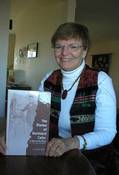Author Unearths Family, World History
By Mike Salmon
January 21, 2004

Mike Salmon
Arline Sachs.

|
|
|
In an acid-free container, wrapped in acid-free paper, the diaries of Bernard Cahn offer a glimpse into the life of a 17th-century Jewish man who marched with Napoleon, raised a family, witnessed the discovery of the train, and monitored the emergence of America on the other side of the Atlantic Ocean.
Springfield resident Arline Sachs spent 20 years researching Cahn, who happens to be her great-great-grandfather.
"He was at the battle of Mainz when the French were defeated," Sachs said. "He was thrown out of the window of the hospital because he was left for dead. He crawled to a rabbi's house."
The walls of Sachs’ home are adorned with memorabilia collected in her quest to document Cahn's life. It all started with the diaries.
"I have the original ones," Sachs said. "My family brought them when they came [from Europe] in 1938."
It wasn't just a matter of reading them, though. The diaries were written in a style of German with Hebrew influences and a touch of Yiddish. They had to be read from right to left, as well. The diaries changed hands several times until 1983, when Sachs got possession of them. She had to incorporate the help of a translator in 1991.
"It took me about 10 years to find out how to read this stuff," Sachs said.
During that time, she visited the Family History Center of the Mormon Church in Annandale, which proved to be a great help. There she found out from a birth certificate that Cahn was born in 1793 in Alsace, France. He became a teacher, was married in 1829, and was a teacher and religious leader from 1830-56.
"He talks a lot about the discoveries," Sachs said. "The first train came in 1840. He comments on anti-Semitism, but anti-Semitism did not really happen to him. It was elsewhere in Europe."
In 1858, Cahn was awarded the Medal of St. Helene (one spelling is Helena) for serving with Napoleon I. The original medal is on Sachs' wall. In 1860, Cahn worked in Germany as a tax collector, and in 1862 his house collapsed and a lawsuit was filed against the builder. Then in 1863, he took a train to visit relatives who lived only about 20 miles away. The train made such a visit practical.
"Some of these things were just so far removed from our current life," Sachs said.
Sachs was not a history buff, but after learning so much history, she became immersed in that period of European history.
"I kept finding out new things. I learned a lot of history. It made the history come much more alive," she said.
Sachs hasn't considered putting Sachs' story in movie form.
"That's above and beyond me," she said. "I'm not sure it's exciting enough for a movie."
Conne Rubenstein, a former teacher and friend of Sachs, helped with the editing. Rubenstein was a former English teacher at Oxon Hill High School in Maryland.
"It was challenging," Rubenstein said. "We did a lot of writing and rewriting."
After a few rejections from publishers, the book finally came out in the fall of 2003. It was published by Avotaynu and is available in two local Jewish bookstores.
Sachs went to several speaking engagements in Europe and hosts "Tracing Your Family Roots" on Fairfax County's Channel 10.
Sidney Sachs, Arline's husband, produced the show. He did a little research on his own family.
"My mother's side we have," Sidney Sachs said. "My dad's side came over in 1882. We knew they were in St. Louis in 1882, but before that we don't know."
Before the book, Sachs had a career with the Northern Virginia Community College as an assistant professor in computer information systems. She worked at the Annandale campus for 23 years.
|

